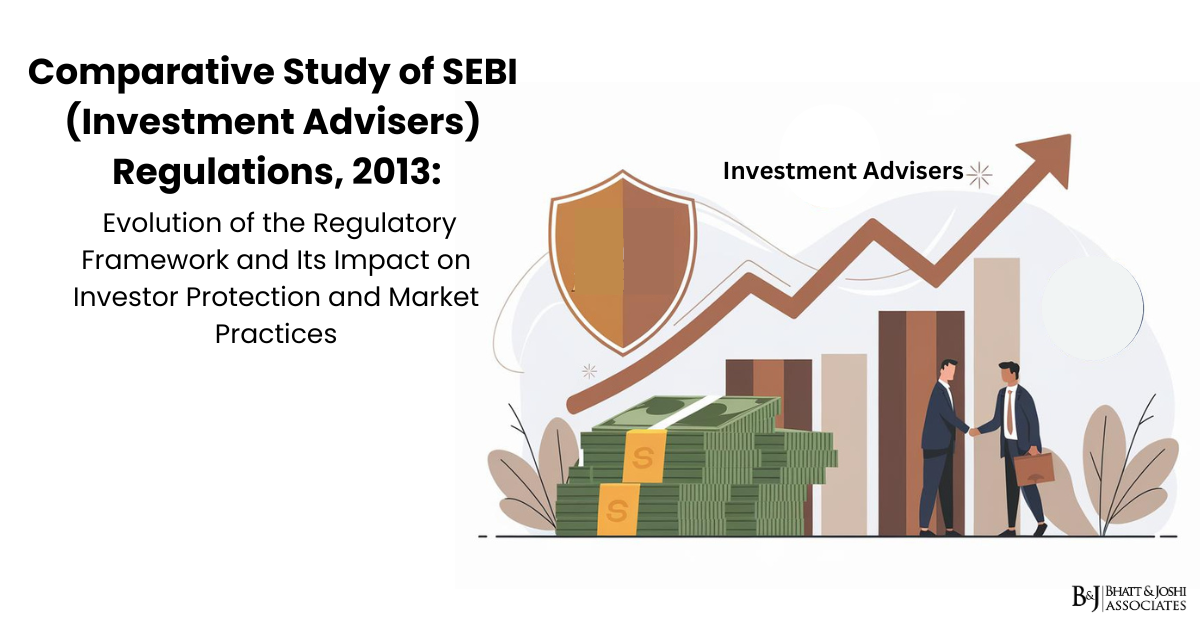Introduction
The financial markets in India have witnessed remarkable growth and evolution over the past few decades, driven by a surge in investor participation, innovation in financial products, and the expansion of the regulatory framework. As investors increasingly sought professional advice to navigate the complexities of financial markets, the role of investment advisers became more prominent. However, this growth also highlighted the need for a robust regulatory framework to protect investors from unethical practices and ensure that investment advisers act in the best interests of their clients. The Securities and Exchange Board of India (SEBI), recognizing this need, introduced the SEBI (Investment Advisers) Regulations, 2013, marking a significant milestone in the regulation of the investment advisory industry in India.
This article provides a comprehensive comparative analysis of the SEBI (Investment Advisers) Regulations, 2013, tracing the evolution of the regulatory framework from its inception to the present day. It explores the key changes and amendments introduced over the years, examines their impact on investor protection and market practices, and assesses the broader implications for the financial advisory industry. By delving into the evolution of these regulations, the article seeks to provide a nuanced understanding of how the regulatory framework has adapted to the changing dynamics of the market and the challenges faced by both investors and advisers.
The Pre-Regulatory Era: Challenges and the Need for Regulation
Before the introduction of the SEBI (Investment Advisers) Regulations, 2013, the financial advisory industry in India operated in a largely unregulated environment. This lack of regulation led to several challenges, including the prevalence of conflicts of interest, the mis-selling of financial products, and a general lack of transparency in the advisory process. Investment advisers were often driven by the commissions they earned from selling specific financial products, rather than by the best interests of their clients. This commission-based model created inherent conflicts of interest, where advisers had financial incentives to recommend products that generated higher commissions, regardless of whether they were suitable for the client.
The absence of standardized qualifications and professional requirements for investment advisers further exacerbated these challenges. Individuals with varying levels of expertise and knowledge could offer financial advice, often without a deep understanding of the complexities involved. This lack of professional standards undermined the quality of advice provided and eroded investor confidence in the advisory industry. Investors were often left vulnerable to unscrupulous advisers who prioritized their financial gain over the needs and objectives of their clients.
The global financial crisis of 2008 served as a catalyst for regulatory reform in the financial advisory industry. The crisis exposed the vulnerabilities within the financial system, including the role played by unethical financial advisers in exacerbating the crisis. In India, while the impact of the crisis was relatively contained, it nonetheless highlighted the need for a more robust regulatory framework to protect investors and ensure the integrity of the financial advisory industry. SEBI recognized the urgent need to introduce regulations that would address these ethical challenges and establish a more structured and transparent environment for the provision of investment advice.
The Introduction of SEBI (Investment Advisers) Regulations, 2013: A New Regulatory Landscape
The SEBI (Investment Advisers) Regulations, 2013 were introduced with the dual objectives of professionalizing the financial advisory industry and protecting investors from unethical practices. These regulations marked a significant departure from the pre-regulatory era, establishing a comprehensive framework that governed the conduct of investment advisers and set out clear guidelines for the provision of investment advice in India.
One of the cornerstone provisions of the 2013 regulations was the requirement for investment advisers to register with SEBI. This registration process was designed to ensure that only qualified and competent individuals or entities could offer investment advice. The regulations stipulated that investment advisers must possess the necessary educational qualifications and professional experience to provide sound financial advice. This provision significantly raised the bar for entry into the industry, helping to elevate the overall quality of advice provided to investors.
In addition to the registration requirement, the SEBI regulations introduced strict guidelines for the management of conflicts of interest. Recognizing that conflicts of interest were one of the primary ethical challenges in the financial advisory industry, SEBI mandated that advisers must act as fiduciaries to their clients. This fiduciary duty required advisers to place their clients’ interests above their own and to avoid situations where their interests might conflict with those of their clients. In cases where a conflict of interest was unavoidable, advisers were required to disclose the conflict to their clients and to take steps to mitigate its impact.
The fiduciary duty imposed by the SEBI regulations was a critical element in promoting ethical behavior within the industry. It ensured that advisers were not motivated by personal gain but were instead focused on providing advice that was in the best interest of their clients. This shift towards a fiduciary model had a profound impact on the adviser-client relationship, fostering greater trust and confidence in the advisory process.
Key Provisions of SEBI (Investment Advisers) Regulations, 2013 and Their Impact on Investor Protection
The SEBI (Investment Advisers) Regulations, 2013 introduced several key provisions that had a profound impact on investor protection. These provisions were designed to address the challenges that had plagued the financial advisory industry in the pre-regulatory era and to create a more transparent and accountable environment for the provision of investment advice.
One of the most significant provisions of the 2013 regulations was the requirement for full disclosure by investment advisers. The regulations mandated that advisers provide comprehensive disclosures to their clients, including information about the adviser’s qualifications, the nature of the advisory services offered, the risks associated with the investment products recommended, and any fees or commissions received by the adviser. This requirement for full disclosure was a critical step towards enhancing transparency in the advisory process and ensuring that clients had access to all the information they needed to make informed decisions.
The disclosure requirements also helped to build trust between advisers and their clients. When clients were fully informed about the advice they received and the potential conflicts of interest that might exist, they were more likely to trust that their adviser was acting in their best interest. This trust was essential for the long-term success of the adviser-client relationship, as it fostered a sense of confidence and security in the advice provided.
Another key provision of the 2013 regulations was the requirement for advisers to act as fiduciaries to their clients. The fiduciary duty required advisers to place their clients’ interests above their own and to provide advice that was fair, unbiased, and free from conflicts of interest. This provision was central to the ethical framework established by the SEBI regulations, as it ensured that advisers prioritized the well-being of their clients over their own financial gain.
The fiduciary duty also required advisers to exercise due diligence in the selection of investment products and strategies. Advisers were required to thoroughly research and evaluate the products they recommended, taking into account factors such as the client’s financial situation, investment objectives, and risk tolerance. This due diligence process helped to ensure that the advice provided was based on sound financial principles and that the recommended products were suitable for the client’s needs.
The introduction of these key provisions had a transformative impact on investor protection. By mandating full disclosure and establishing a fiduciary duty, the SEBI regulations created a more transparent and accountable advisory environment, where clients could have confidence that the advice they received was genuinely in their best interest.
The Evolution of SEBI (Investment Advisers) Regulations 2013: Amendments and Their Implications
Since the introduction of the SEBI (Investment Advisers) Regulations, 2013, the regulatory framework has undergone several amendments, each designed to address emerging challenges and to strengthen investor protection. These amendments have played a critical role in ensuring that the regulations remain relevant and effective in the face of a rapidly evolving financial advisory industry.
One of the most significant amendments to the SEBI regulations was introduced in 2020. This amendment aimed to further enhance investor protection by tightening the regulatory requirements for investment advisers and by addressing some of the gaps that had been identified in the original 2013 regulations. One of the key changes introduced by the 2020 amendment was the separation of advisory and distribution services. Under the amended regulations, an individual or entity could no longer offer both advisory and distribution services. This separation was designed to eliminate the conflicts of interest that arose when advisers recommended products that they also sold, thereby ensuring that the advice provided was genuinely in the best interest of the client.
The 2020 amendment also introduced stricter qualification requirements for investment advisers. The amended regulations required advisers to possess higher educational qualifications and to have completed relevant certifications before they could offer investment advice. This change was intended to raise the standard of professional competence within the industry and to ensure that advisers had the necessary expertise to provide sound financial advice.
Another significant change introduced by the 2020 amendment was the requirement for advisers to maintain a specific capital adequacy. This requirement was designed to ensure that advisers had sufficient financial resources to meet their obligations to their clients and to operate their advisory business in a financially sustainable manner. The capital adequacy requirement also provided an additional layer of protection for clients, as it reduced the risk of advisers defaulting on their obligations.
The 2020 amendment also introduced enhanced disclosure and reporting requirements. Advisers were required to provide more detailed disclosures to their clients, including information about the performance of the recommended investment products and the rationale behind their recommendations. The amended regulations also required advisers to submit regular reports to SEBI, detailing their compliance with the regulatory requirements and providing information about their advisory activities.
The introduction of these amendments had a significant impact on investor protection and market practices. By tightening the regulatory requirements and enhancing the transparency of the advisory process, the amendments helped to create a more professional and accountable industry. The separation of advisory and distribution services, in particular, was a critical step towards eliminating conflicts of interest and ensuring that advisers acted in the best interest of their clients.
The Impact of SEBI Regulations on Market Practices
The SEBI (Investment Advisers) Regulations, 2013, along with the subsequent amendments, have had a profound impact on market practices within the financial advisory industry. The introduction of these regulations has led to a fundamental shift in the way investment advisers operate, with a greater emphasis on ethical conduct, transparency, and accountability.
One of the most significant changes in market practices has been the move away from commission-based advisory models towards fee-based models. The SEBI regulations, particularly the fiduciary duty and conflict management provisions, have encouraged advisers to adopt fee-based models, where they are compensated based on the quality of their advice rather than the sale of financial products. This shift has helped to align the interests of advisers with those of their clients, reducing the potential for conflicts of interest and improving the overall quality of advice provided.
The regulations have also led to the professionalization of the financial advisory industry. The requirement for advisers to possess specific qualifications and to register with SEBI has raised the standard of professional competence within the industry. Advisers are now expected to have a deep understanding of the financial products and strategies they recommend, and to provide advice that is based on sound financial principles. This professionalization has helped to build trust between advisers and their clients and has contributed to the growth and development of the advisory industry in India.
The impact of the SEBI regulations on market practices is also evident in the increased focus on client education and awareness. The disclosure requirements mandated by the regulations have placed a greater emphasis on ensuring that clients fully understand the advice they receive and the risks associated with the financial products they are recommended. Advisers are now expected to take a more proactive role in educating their clients and helping them make informed decisions about their investments.
The separation of advisory and distribution services, introduced by the 2020 amendment, has also had a significant impact on market practices. By eliminating the conflicts of interest that arose from the dual role of advisers as both advisers and distributors, the amendment has created a more transparent and client-centric advisory environment. This separation has also encouraged the development of specialized advisory services, where advisers focus solely on providing advice, free from the influence of product sales.
Challenges and Criticisms of SEBI (Investment Advisers) Regulations, 2013
While the SEBI (Investment Advisers) Regulations, 2013 and the subsequent amendments have made significant strides in enhancing investor protection and improving market practices, they are not without their challenges and criticisms. One of the primary criticisms of the regulations is the increased compliance burden they place on investment advisers, particularly smaller, independent practitioners.
The requirement for advisers to register with SEBI, maintain specific qualifications, and comply with strict disclosure and reporting requirements can be time-consuming and costly, particularly for smaller firms. This increased compliance burden has led to concerns that the regulations could stifle innovation and competition within the advisory industry, as smaller firms may struggle to meet the stringent regulatory requirements.
Another challenge associated with the SEBI regulations is the enforcement of the fiduciary duty and conflict management provisions. While the regulations require advisers to act in the best interest of their clients and to disclose conflicts of interest, the practical implementation of these requirements can be challenging. In some cases, advisers may be reluctant to disclose conflicts of interest, particularly if doing so could result in a loss of income. Additionally, clients may not always fully understand the implications of a disclosed conflict of interest, making it difficult for them to make informed decisions.
The separation of advisory and distribution services, while a positive step towards eliminating conflicts of interest, has also faced criticism. Some industry stakeholders argue that the separation could limit the availability of financial products to clients, as advisers may no longer be able to recommend products they do not distribute. This could reduce the diversity of investment options available to clients and limit their ability to build a well-diversified portfolio.
Broader Implications for the Financial Advisory Industry
The SEBI (Investment Advisers) Regulations, 2013 and the subsequent amendments have had far-reaching implications for the financial advisory industry in India. By establishing a comprehensive regulatory framework that promotes ethical conduct, transparency, and accountability, the regulations have helped to create a more professional and client-centric industry.
One of the broader implications of the regulations is the increased focus on client education and awareness. The requirement for investment advisers to provide detailed disclosures and to act in the best interest of their clients has placed a greater emphasis on client education. Advisers are now expected to ensure that their clients fully understand the advice they receive and the risks associated with the financial products they recommend. This focus on client education has helped to empower investors, enabling them to make more informed decisions and to take greater control of their financial futures.
The regulations have also had implications for the business models employed by investment advisers. The emphasis on fiduciary duty and conflict management has encouraged advisers to adopt more transparent and client-centric business models. For example, many advisers have moved away from commission-based models, where their income is tied to the sale of financial products, and have instead adopted fee-based models, where they are compensated based on the quality of their advice. This shift has helped to align the interests of advisers with those of their clients, reducing the potential for conflicts of interest and improving the overall quality of advice provided.
The SEBI regulations have also contributed to the professionalization of the financial advisory industry. The requirement for advisers to possess the necessary qualifications and to register with SEBI has helped to elevate the overall quality of investment advice in the industry. By ensuring that only qualified and competent individuals are permitted to offer investment advice, the regulations have helped to build trust between advisers and their clients, which is essential for the long-term success of the industry.
Conclusion
The SEBI (Investment Advisers) Regulations, 2013 represent a significant milestone in the regulation of the financial advisory industry in India. By establishing a comprehensive regulatory framework that promotes ethical conduct, transparency, and accountability, SEBI has helped to create a more professional, client-centric, and trustworthy industry. The regulations have had a profound impact on investor protection and market practices, fostering a greater emphasis on fiduciary duty, transparency, and client education.
However, the regulations are not without their challenges. The increased compliance burden, the enforcement of fiduciary duties, and the separation of advisory and distribution services are all areas that require ongoing attention and refinement. As the financial advisory industry continues to evolve, it will be important for SEBI to address these challenges and to ensure that the regulatory framework remains effective in protecting investors and promoting ethical conduct.
Overall, the SEBI (Investment Advisers) Regulations, 2013 and the subsequent amendments have had a transformative impact on the financial advisory industry in India. While the regulations have helped to elevate ethical standards and to protect investors, they have also created new challenges for investment advisers. Going forward, it will be essential for SEBI to continue to monitor the impact of these regulations and to make any necessary adjustments to ensure that the financial advisory industry remains vibrant, competitive, and ethical. The success of these regulations will ultimately depend on their ability to adapt to the changing needs of the market while maintaining their core objectives of protecting investors and ensuring ethical conduct.













